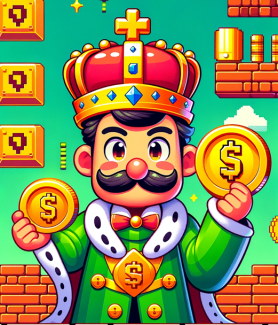
Cash is King...but Our Princess is in Another Castle
Recently, we’ve had a lot of clients ask about where to put excess cash to get the best bang for their buck, which tells me it's a topic on a lot of people's minds.
So let's talk about it!
After over a decade of historically low interest rates, higher cash yields have been a welcome development across all cash instruments including savings accounts, CDs, and money market funds. This is because the Fed raised rates rapidly from early 2022 to mid-2023 and has kept the federal funds rate in a range of 5.25% to 5.50% since last July.
At the same time, interest rates on cash are at their highest levels in decades, making King Cash's offer of seemingly "risk-free" returns VERY attractive.
Money market funds, for instance, have attracted massive inflows with total assets reaching new all-time highs of $6.1 trillion. This is more than double the assets held in money market funds prior to the pandemic when interest rates were near zero for the better part of a decade.
As the below chart shows, money market fund assets have typically grown in times of economic distress or when interest rates have been high.
Now don’t get me wrong, cash is an essential part of any financial and investment plan. It provides the liquidity needed to cover expenses and important life events you expect to experience in the next 18 months.
But…visiting King Cash’s castle should be only a side quest in pursuit of your ultimate goals.
The Opportunity Cost
Despite the juicy rates King Cash is offering today, cash is NOT the place for long-term savings. While there are many cash instruments yielding over 4%, the problem remains that these rates are not "locked in."
The second (and most important) challenge with holding excess cash is the opportunity cost of not investing in stocks or bonds. Just as interest rates have risen for cash, yields have also jumped across many types of bonds. The average yield on U.S. investment grade corporate bonds, for instance, is now 5.5%. Unlike cash, these yields are longer-term in nature, come with the "locked-in" feature, and will experience price appreciation if (and when) rates do decline.
The stock market has also performed extremely well despite many investor concerns over the past few years. The S&P 500 is up over 15% YTD and 68% since the market bottom in 2022. While the past is no guarantee of the future, these returns have far outpaced inflation and have helped to offset the erosion of purchasing power across diversified portfolios.
The above chart makes this opportunity cost clear. Due to inflation, what in 1926 cost one dollar, now costs $18. However, the stock market has significantly outpaced inflation over long periods of time. A hypothetical one dollar investment in the stock market in 1926 would be worth over $16,000 today. A similar investment in intermediate-term bonds would be worth $109, also well outpacing inflation.
Thus, while short-term investments play important roles in financial plans and portfolios, it's critical in today's market environment to avoid holding too much cash for the wrong reasons.
Bottom line - King Cash may make sense for short side quests, but history shows that our Princess is in another castle!
P.S. If you found this useful, or need help determining how much cash is too much cash and how to optimize it, reach out to us at info@radixfinancial.com. We'd love to help.

